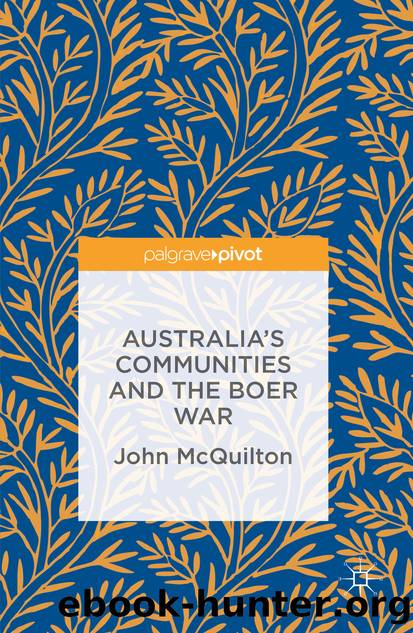Australia's Communities and the Boer War by John McQuilton

Author:John McQuilton
Language: eng
Format: epub
Publisher: Springer International Publishing, Cham
Souvenirs, the Tommy, Tucker, âTip Topâ and Home
The regionâs men were keen tourists. Some visited the graves of the men killed during the war. Others visited sites of historic significance, like the ruins at Zimbaybe. 36 They also sent a steady stream of souvenirs back home: the hides of animals killed which were turned into native shields, shrapnel from Mafeking, objects purchased from African tribes, postcards and shell casings. 37 When life was dull, they challenged English regiments to mini Ashes series. And the men speculated endlessly about the duration of the war. Some were confident that the war could not last long. Mahy, for example, predicted its end no less than five times. Henry Crisfield, however, believed it could go on for years. 38
At first, the Tommy fascinated the men: this was the paragon against whom they would be measured. Initial reactions were often a mixture of the positive and the curious. Both Stanley Fletcher and James Dare praised the Yeomanry as âfine fellowsâ and âgood soldiersâ. Percy King, however, could not understand them because their accents and vocabulary were âstrangeâ. Mahy could not believe that Scottish highland regiments fought in kilts, but he was delighted to discover that the Gordons, seen as âgiantsâ by the popular press, turned out to be âjust men like the rest of usâ and âjust as big liarsâ. 39 Familiarity, however, brought about a rapid reassessment. Mick Sharry thought the Yeomanry âa poor lotâ with no bush skills. Other letters claimed that the Tommies were more susceptible to malaria and enteric fever. And their horsemanship was woeful. Respect for the Tommy as a fighting man disappeared. Drummond was particularly scathing. The Australians did all the fighting, he bluntly asserted, because British mounted troops were âslowâ in getting to the action. 40 And James Clingin firmly believed âour biggest enemy is the Tommyâ. If the Tommy found two or three Australians and they numbered a dozen âthey will belt usâ. But if the numbers were even, the Tommies gave the Australians a wide berth. 41
The men rarely commented on the generals but had plenty to say about their officers. Cudgewaâs George Barber thought them a positive hindrance: he relished patrols where there were no officers to âinterfereâ with the troopersâ tactics. Quinlan had nothing but contempt for his captain, especially after he put the men on rations for the âbenefit of their healthâ. Robert Carlisle doubted that the captains and the lieutenants had the confidence of the men. Wangarattaâs Colonel Hoad, however, had the respect of local men writing home and Colonel Tom Price, a âbullyâ in camp, was praised as the best man to lead his troops into action. 42
Food was a constant theme in the letters home. Patrols on the veldt were poorly supplied, and the men had little time for the British Armyâs staples of bully beef and biscuits, the biscuits in particular. They were as âhard as the hobs of hellâ and needed a hammer to break them up. 43
Download
This site does not store any files on its server. We only index and link to content provided by other sites. Please contact the content providers to delete copyright contents if any and email us, we'll remove relevant links or contents immediately.
| Africa | Americas |
| Arctic & Antarctica | Asia |
| Australia & Oceania | Europe |
| Middle East | Russia |
| United States | World |
| Ancient Civilizations | Military |
| Historical Study & Educational Resources |
The Light of Days by Judy Batalion(1063)
First Platoon: A Story of Modern War in the Age of Identity Dominance by Annie Jacobsen(902)
Stalin's War: A New History of World War II by Sean McMeekin(861)
The Pacific War 1941-1943 by James Holland(803)
Walk in My Combat Boots by James Patterson(764)
The American War in Afghanistan by Carter Malkasian(741)
Victory's Price (Star Wars) by Alexander Freed(734)
The Vietnam War: An Intimate History by Geoffrey C. Ward & Ken Burns(721)
Blood and Ruins: The Great Imperial War, 1931-1945 by Richard Overy(686)
Operation Pedestal by Max Hastings(683)
Concepts of Space by Jammer Max;(667)
Cold War (Alexander King Book 2) by Bradley Wright(660)
Extreme Fitness by Chris McNab(654)
The Madman Theory by Jim Sciutto(651)
Flying Tiger by Samson Jack(633)
World War II Infantry Fire Support Tactics by Gordon L. Rottman(612)
Pathfinders by AL-KHALILI JIM(611)
Panzerkrieg by Mike Syron(599)
Bismarck by Jean-Paul Bled(585)
